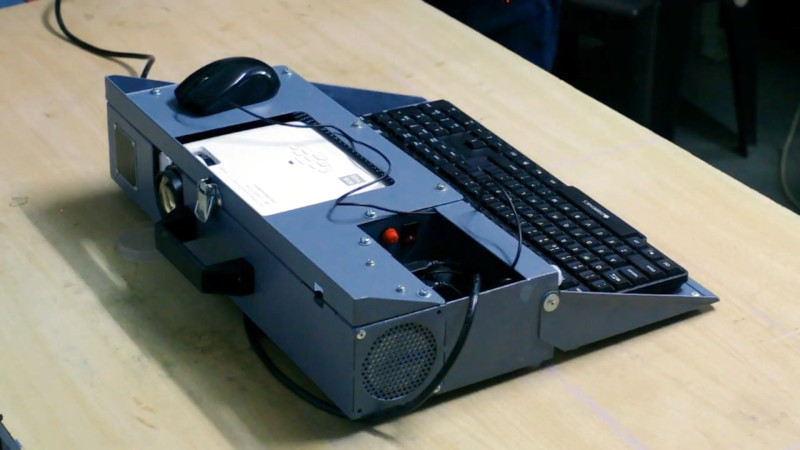We cover a lot of cyberdeck projects here at Hackaday, custom portable computers often built around the Raspberry Pi. It’s not often that we cover a computer that perfectly achieves and exceeds what a cyberdeck is trying to do without being a cyberdeck in any way, but that’s what [Subir Bhaduri] has done. In addressing the need for Indian schoolchildren to catch up on two years of COVID-disrupted schooling he’s created the pπ, a Raspberry Pi, projector, and keyboard all-in-one computer in a neat sheet-metal case that looks as though it might be just another set of spanners or similar. At a stroke he’s effortlessly achieved the ultimate cyberdeck, because this machine is no sci-fi prop, instead it has a defined use which it fulfills admirably.
All the files to build your own can be found in a GitLab repository. The case is laser-cut sheet metal, and he’s put in a cost breakdown which comes out at a relatively healthy 17200 Indian rupees, or around 230 US dollars. We hope that it serves its purpose well and provides a rugged and reliable teaching aid for a generation from whom COVID has taken so much. You can see more in the video below the break.

















The pee-pie? Pie-Pie? The pee-pee?
I’d call it rho-pi! ρπ
That nickname sounds a bit ropey.
Yay! Practical cyberdeck!
Very cool, though I’d probably want to do something more to protect the projector lens – at least recess it?
Seems fairly protected by the carrying handle, and there is a lens cap under it.
The carrying handle doesn’t cover the lens (though it might offer some protection), and a lens cap isn’t designed to protect against a hard knock. Remember the use case is rural Indian schools, so I’d expect it’ll be carted around on bumpy roads.
I love this idea, but I would hope for a second screen (or far better but far more complex: an interactive prpjecting surface by way of a camera) because I find it very demotivating when a teacher is talking to the slides instead of to the class.
Perhaps instead of a camera (which I think would need too much computing power to do the job right) put a pair of IR laser spots aimed at the bottom edge of the screen basically any distance apart and use a Wiimote for interaction pointing etc. I’ve been thinking of doing something similar with a Wiimote for similar reason for quite some time – added bonus of doing it this way over the camera way is the lecturer is able to work very much the same as if it was a chalk board pointing clearly to x or y but without ever getting in the way of the projection or worrying about walking out of the cameras frame.
That’s a very good idea. I hope you share your efforts!
Yeah, I’m not great at that. But have been thinking I should try harder (actually have a less annoying to use in my space camera tripod replacement in work on my lathe now).
Either way this idea isn’t something I am likely to pursue any time soon, so if anybody else wants to run with it I’d love to see the results myself. (The original need that inspired the thought has passed and I have far more ideas than I could ever actually produce, some that seem pressing or important (like the ‘tripod’ so I might actually document my work).)
Are you sure the drivers for this don’t already exist? People have been hacking Wiimotes since pretty much the start.
this should get you going: https://github.com/alduxvm/pyIRCamera
What’s wrong with just using the mouse?
For the usecase I had in mind that there isn’t a mouse or surface to run one one, and in this situation its less than ideal in my opinion as it tethers the lecturer to the machine, which then means they are likely lecturing to the wall – as the only way to see where the mouse pointer is and use the mouse is sat down facing the projection the whole time – you really want to see the glazed over face of going over your audiences head or the question raised by the kid that sees the connection between what you are saying and something else etc…
Or just get a proper air mouse, and you don’t need to setup any tracking points.
Shouldn’t need to do any work with the tracking points with this method anyway – the geometry is backed in when you build it and that means you should get reliable and natural feeling pointing.